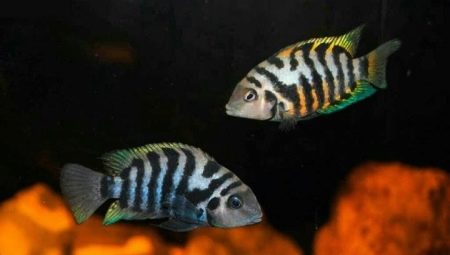Black-striped cichlazoma is the smallest species of American cichlids and is well known to aquarists. The popularity of the fish is due to its unpretentiousness, good survivability and non-conflict nature.
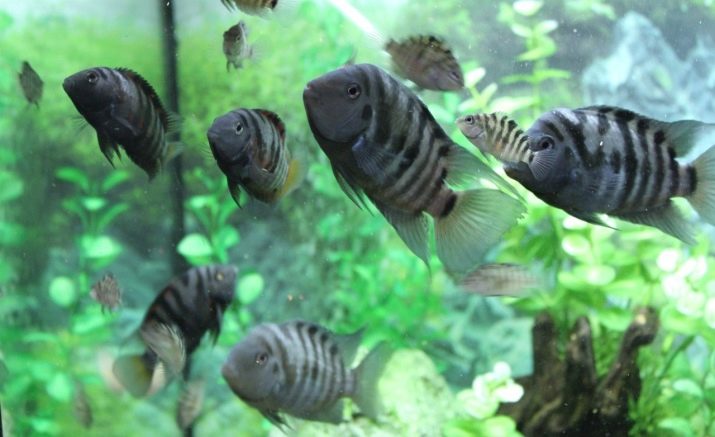
Description
The black-stripe cichlase (lat. Cichlasoma nigrofasciatum) can be found literally in every home aquarium. These are small fish ranging in size from 13 to 15 cm, with an elongated, slightly flattened laterally high body and large head. Fish have a very interesting striped color, the intensity of which can vary. This is due to the presence of pigment-containing cells - a chromatophore, the compression of which leads to a loss of color saturation.
The gray-blue color with black stripes makes the fish almost invisible in open waters, masking it on a rocky and overgrown vegetation bottom. In total, there are 8-9 vertical stripes on the body of cichlazoma, and the strip immediately following the gills is interrupted and becomes similar to the letter U.
There are also depigmented varieties of cichlazoma - albinos. The loss of color pigment is a genetic anomaly and is accompanied by a general decrease in fish immunity. Such individuals require the creation of more comfortable conditions, are less hardy in comparison with colored individuals and are more often sick. Albino fish can be found both in natural reservoirs and in aquariums.
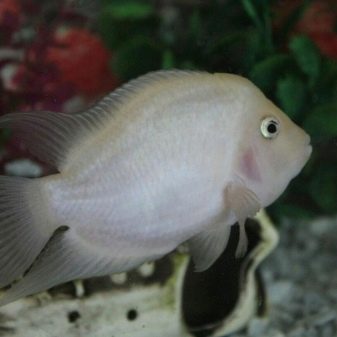
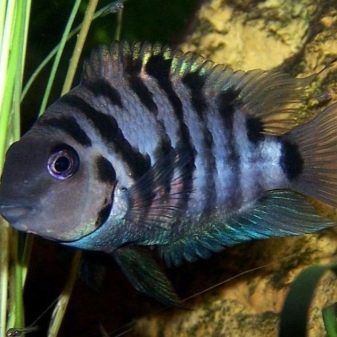
The black-banded cichlazoma is distinguished by large expressive eyes, protected by a deep leathery fold. The mouth is located at the top of the head and has fleshy large lips.The dorsal and anal fins in most individuals are slightly pointed in the anus and are transparent, although fish also have yellowish fins.
"Zebras" often participate in breeding experiments, as a result of which it was possible to obtain individuals with the absence of stripes and the presence of different body colors. As an example, mention may be made of flamingo cichlazoma, which has a pale pink color with orange sparkles.
Under natural conditions, black-striped cichlazomas prefer to settle in reservoirs with a rocky bottom, where there is always the opportunity to hide in a cave, crevice and other natural shelter. The depth of the pond is absolutely not important for fishTherefore, they can be found both in a deep, deep river, and in a small stream. In large rivers and lakes, cichlomas prefer to dwell along the coastline, and the largest populations were observed in places with a strong current and an abundance of food in the form of larvae, worms, small fish and aquatic plants.
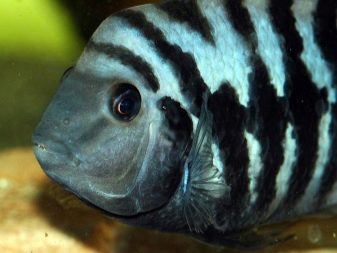
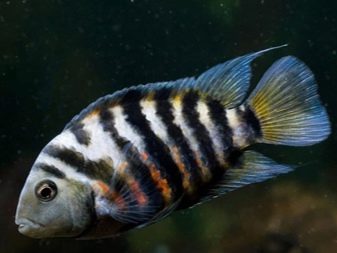
Describing black-striped cichlases, it should be noted striking features of their character. Fish still in their young age form pairs that last a lifetime. They are very good parents, carefully look after their offspring and preserve it for a long time. In addition, cichlomas are the most peaceful species of American cichlids and without problems coexist in the aquarium with other fish. Cichlazomas are very undemanding in maintenance and forgive owners of flaws in leaving.
In the wild, zebra cichlids live in fresh water bodies in countries such as Honduras, Nicaragua, Panama, Guatemala, Costa Rica, Indonesia and the United States. The fish became familiar to European aquarists thanks to sales agent Johann Paul Arnold, who asked familiar sailors to bring these exotic fish from the voyage.
After receiving a valuable cargo and consultations with leading German zoologists, he made a description of the species and systematized the information available about it. Aquarists appreciated the attractiveness and unpretentiousness of black-striped cichlases, and since 1867, "zebras" have firmly held a leading position in popularity among other aquarium fish.
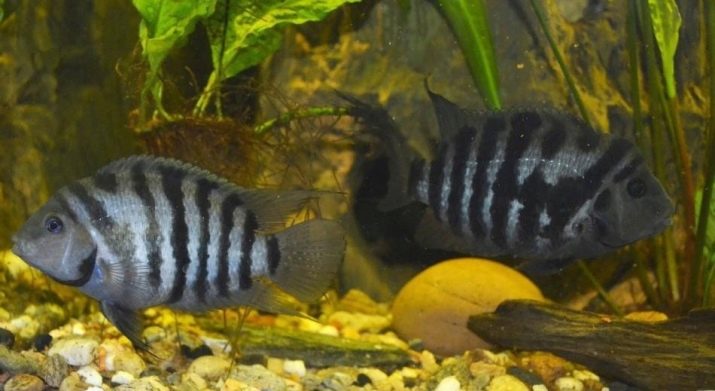
How to distinguish a female from a male?
It will not be difficult to determine the sex of the black-striped cichloma, since the females in appearance differ markedly from males. Males have larger body sizes and a noticeable fat growth on the forehead, which appears in them over time. But if you can make a mistake with the size, especially in adolescence, then the presence of a bright color and more contrasting stripes of females allows you to accurately determine the sex of the fish.
Besides, males lack orange abdomencharacteristic for females preparing for spawning. There is a difference in the fins: in males they are more elongated and pointed than in females.

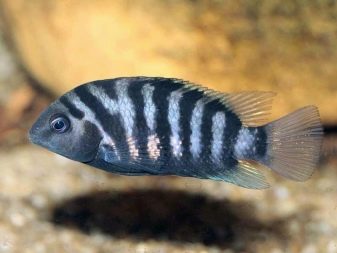
Content Rules
Black-striped cichlasomas are very picky fish and are well suited for beginners. Among experienced aquarists, there is a joke that zebra cichlids can spawn even in a plastic bag during transportation - so these fish are unpretentious and undemanding to the conditions of detention.
They easily live up to 10-15 years and practically do not get sick. Therefore, it is not so difficult to provide cichlazoma with an optimal content. For this, it is necessary to maintain the temperature of the water in the aquarium within 20-28 degrees, the hardness index is from 8 to 30 dH, and the acidity level is 7-8 pH.
It is advisable to select a spacious aquarium for keeping cichlases so that the fish can have their own angle, where other species will not bother them. The best option is to keep the fish in pairs, as the male and female are so passionate about each other, and then their offspring, that they do not care about those around them. The average size of the aquarium for one pair of cichlases should be not less than 75 liters. At the same time, it must be present inside small flow, and the water be clean and transparent.
Black-striped cichlazomas do not belong to the category of clean fish and very quickly pollute water. This is due to the fact that they often leave behind food and like to dig up the soil. Therefore, it is necessary to wash the aquarium for this type of cichlids more often than for other fish.
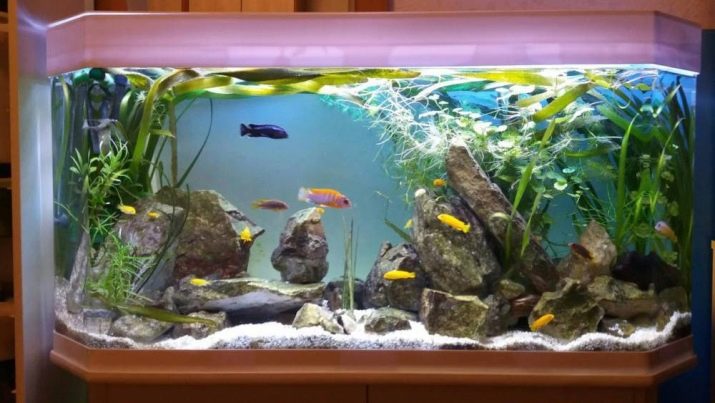
As for the filtration and aeration of water, if the aquarium is small and only a couple of fish live in it, you can do without the appropriate equipment. If the tank has a sufficient volume and is densely populated by inhabitants, then the installation of a compressor and a filter is mandatory. In addition to purifying the water, the filter creates a small flow that is required for the development of caviar. Regarding filter power, experienced aquarists It is advised to select it according to the size of the aquarium so that it can drive through itself two volumes of water per hour.
Water is replaced weekly, changing at a time up to 30% of the volume. Aquarium lighting can be either upper, or lateral or frontal: cichlasomas are not very demanding on this factor, so the choice of backlighting depends on the personal preferences of the owner.
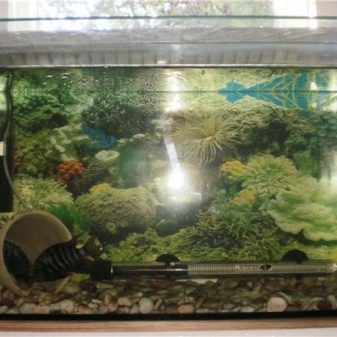
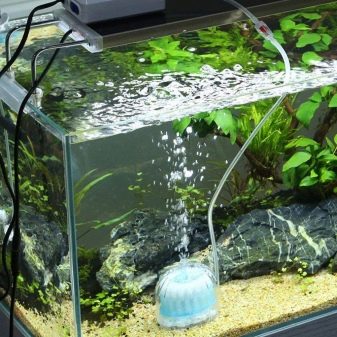
Aquarium equipment
The most important point when filling an aquarium before starting it is the choice of soil. Black-striped cichlids, like all cichlids, prefer to arrange redevelopment of the substrate at their discretion, therefore, pebbles of small or medium size should be used as soil, for lack of which granite chips or gravel can be used. If these rules are neglected and ordinary sand is poured into the aquarium, then turbidity will constantly rise from the bottom, and the water will be dirty and opaque.
After the soil is selected, it's time to start zoning the aquarium. This requirement is due to the need to have its own territory, which is characteristic of most types of American cichlids. Zoning is carried out using snags, large stones, ceramic fragments and coconut shells., building from them caves, labyrinths and all kinds of shelters.
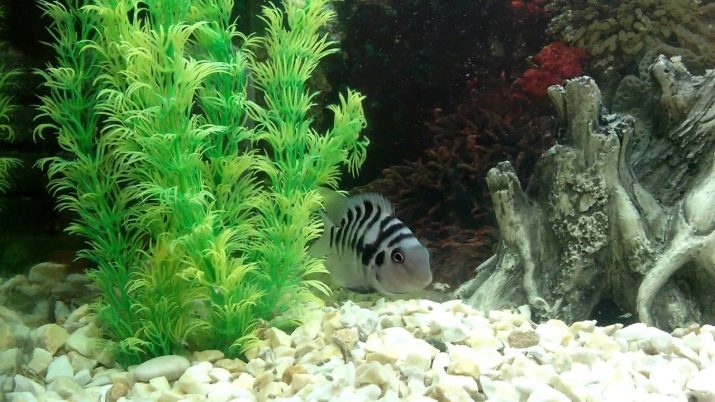
Aquarium plants with a powerful root system, such as echinodorus, cryptocoryne and vallisneria spiral. These plants perfectly purify water from phosphate and nitrate impurities and saturate it with oxygen.
However, their roots cannot be left uncovered, otherwise they will be mercilessly torn out of the ground. They should be blocked with large stones or purchased decorations so that the fish can hide in them without destroying the integrity of the root system.
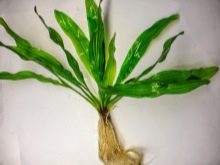
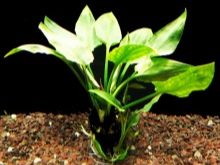

In addition, the presence of a flat stone or pot is mandatory at the bottom of the aquarium, where cichlomas will spawn. It should also be remembered that it is not recommended to place algae with a weak root system in aquariums with cichlids.
This is because there is no special need for fish in them, moreover, they will be immediately pulled out of the ground. Floating plants such as duckweed, richchia, pistia and wolfia can be used as a decorative component. In addition to shading and making the aquarium attractive, these algae will act as a good supplement to the diet with cichlases.
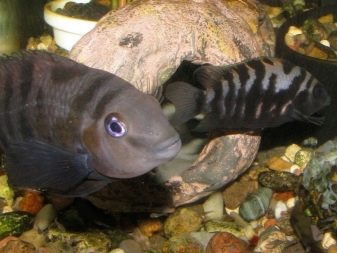
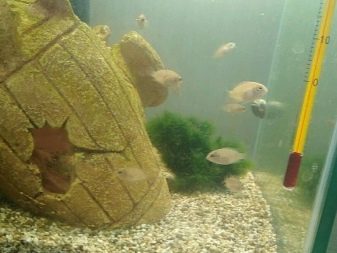
What to feed?
Feeding black-striped cichlases is not much different from feeding other types of fish and requires a balanced diet, including live food and plant foods. Pisces really like bloodworms, brine shrimp, tubeman, saltwater fish and squid, and from the vegetation they will not give up green peas, spinach, zucchini, fresh cucumbers, scalded cabbage, oatmeal and lettuce.
With natural feeding, you can make a weekly diet based on the needs and number of fish, and enter it in the table. This will prevent the supersaturation of fish with one product against the background of a shortage of the other and will contribute to a more balanced diet.
In addition, you should determine the fasting day and mark it in the table. The need for such a day is due to the tendency of black-striped cichlases to overeat, which is why they quickly grow fat and become more lethargic and painful.
Natural products can be replaced with ready-made balanced feeds, in which all the necessary vitamins and minerals are present in the right dosages and optimal combinations. For feeding, you can use dry, freeze-dried, frozen and live food, since cichlomas, like all cichlids, are very unpretentious and eat everything.
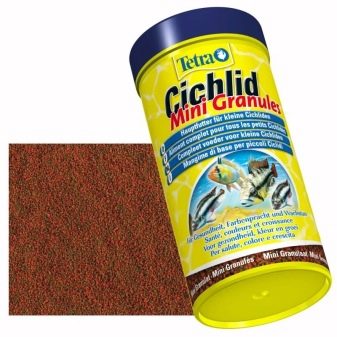

Breeding
Breeding black-striped cichlases is simple, for this it is enough to create optimal conditions for spawning and rely on nature. Maturity in cichlids occurs in 7-10 months, the fish form strong pairs and are good parents. Spawning can continue all year round at small intervals, and the stimulus for it is often heating the water in the aquarium to 29 degrees and replacing 1/4 of its volume with fresh.
To obtain good offspring, experienced aquarists recommend placing the couple in a separate container, but if this is not possible, there is nothing to worry about, since prolific cichlomas can multiply in the general aquarium.
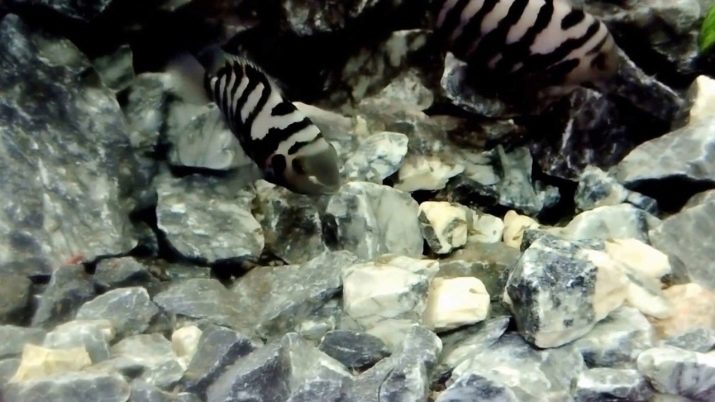
The courtship of the male for the female lasts long enough, after its completion, the female proceeds to lay eggs. To do this, she uses large flat stones, a coconut shell, a ceramic pot or a large shell. However, there are frequent cases when eggs are laid directly on the leaf of a large plant. If the caviar was deposited in a common aquarium, then the couple will zealously guard it, not letting strangers close. Periodically, the female examines the clutch and removes dead and unfertilized eggs from it.
3 days after laying eggs, larvae begin to hatch from it, the yolk sac breaks up, and fry appear in the light. Typically, their number is 100-200 pieces, depending on the age of the couple and the conditions of detention. The first 3 days they feed on the remnants of their sac and do not sail anywhere, and then begin to move around the aquarium under the vigilant control of the parental couple. In this case, the female specifically waves the fins near the bottom, raising all the dregs from it.


In the suspended suspension, the fry seek out food for themselves, and by the end of daylight the well-fed family returns to its shelter. However, despite the high parental instincts, some males after the appearance of fry become very aggressive and if they are not isolated in time in another aquarium, they can eat all the fry. therefore after the appearance of the offspring, the aquarist must carefully monitor the behavior of the father of the family and, if necessary, take measures to immediately resettle him.
In the aquarium with fry, a filter and a compressor must be installed, and crushed as a starting food mix of live and dry feedin. 3 weeks after birth, the fry switch to a common diet and begin to eat the same way as their parents. The next spawning can be expected in a month, and it will bring about the same number of fry. However, it is worth noting that if spawning occurs in a common aquarium, then, despite the vigilant guardianship of parents, not all fry survive.
After the fry become independent fish, you need to decide on their future fate. Most aquarists sell or give away surplus stockotherwise, the proliferated cichlazomas will not give a quiet life to other species, and the aquarium risks becoming mono-species.
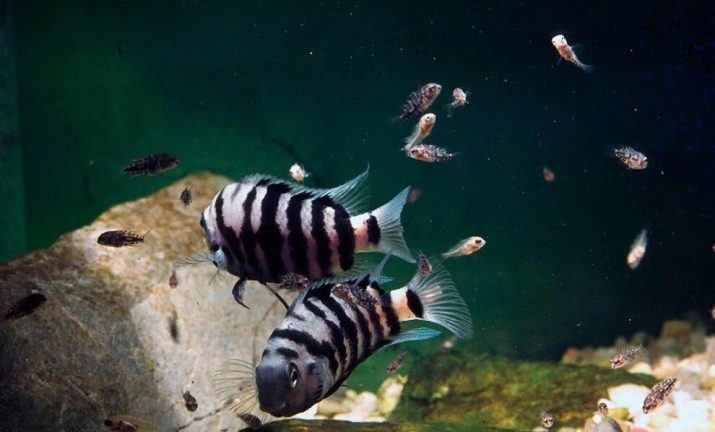
Fish compatible
In general, black-banded cichlazomas get along well with other species, however, exceptions to the rules do occur. So, the male sometimes chases neighbors in the aquarium, which is especially often the case during spawning and caring for fry.However, such attacks are cyclical in nature, and cichlazomas quite get along with peace-loving species of not too large sizes.
As neighbors, you can use fish such as swordsmen, barbs, pearl gourami, thorns, parrots, diamond cichlazomas and mollies. In addition, the "zebras" get along well with labeos, cockroaches and speckled catfish. However, catfish, due to their near-bottom lifestyle, can interfere with cichlazoma to lay eggs, which is why such a neighborhood often leads to disassembly and brawls.
In addition, you should not overpopulate the aquarium with many different, albeit peaceful species.
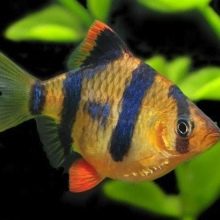
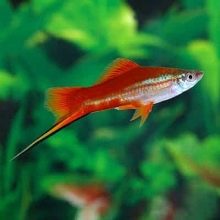
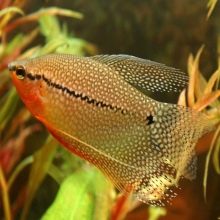
But with such fish as piranhas, cancers and astronotuses, cichlazomas do not get along. Also, the presence of cherry barbs, red, blue and black neons, rassbori, guppies and other too small species is undesirable. The ideal option would be to maintain a monovid aquarium, where black-striped cichlazomas will be full-fledged hosts.
Next, watch a video with tips on how to properly maintain black-striped cichlosoma.
